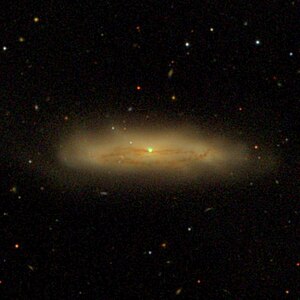NGC 5506
| Galaxy NGC 5506 |
|
|---|---|

|
|
| SDSS recording | |
| AladinLite | |
| Constellation | Virgin |
|
Position equinox : J2000.0 , epoch : J2000.0 |
|
| Right ascension | 14 h 13 m 14.9 s |
| declination | -03 ° 12 ′ 27 ″ |
| Appearance | |
| Morphological type | Sa / pec / sp / Sy1.9 |
| Brightness (visual) | 11.9 likes |
| Brightness (B-band) | 12.8 mag |
| Angular expansion | 2.7 ′ × 0.8 ′ |
| Position angle | 95 ° |
| Surface brightness | 12.6 mag / arcmin² |
| Physical data | |
| Redshift | 0.006181 ± 0.000027 |
| Radial velocity | (1853 ± 8) km / s |
|
Stroke distance v rad / H 0 |
(81 ± 6) · 10 6 ly (24.9 ± 1.7) Mpc |
| history | |
| discovery | Wilhelm Herschel |
| Discovery date | April 15, 1787 |
| Catalog names | |
| NGC 5506 • UGCA 387 • PGC 50782 • CGCG 018-081 • MCG + 00-36-28 • IRAS 14106-0258 • 2MASX J14131490-0312272 • GC 3806 • H II 687 • h 1757 • UGCA 387 • LDCE 1076 NED004 | |
NGC 5506 is a spiral galaxy with an active nucleus of the Hubble type Sa / P in the constellation Virgo on the ecliptic . It is an estimated 81 million light years away from the Milky Way and about 65,000 light years in diameter. Together with NGC 5507 it forms a gravitationally bound galaxy pair.
The galaxy IC 985 is located in the same area of the sky .
The object was discovered on April 15, 1787 by Wilhelm Herschel with an 18.7-inch reflector telescope, who described it as "pB, cL, mE 20 degrees sp-nf".
Photo from the Hubble Space Telescope

